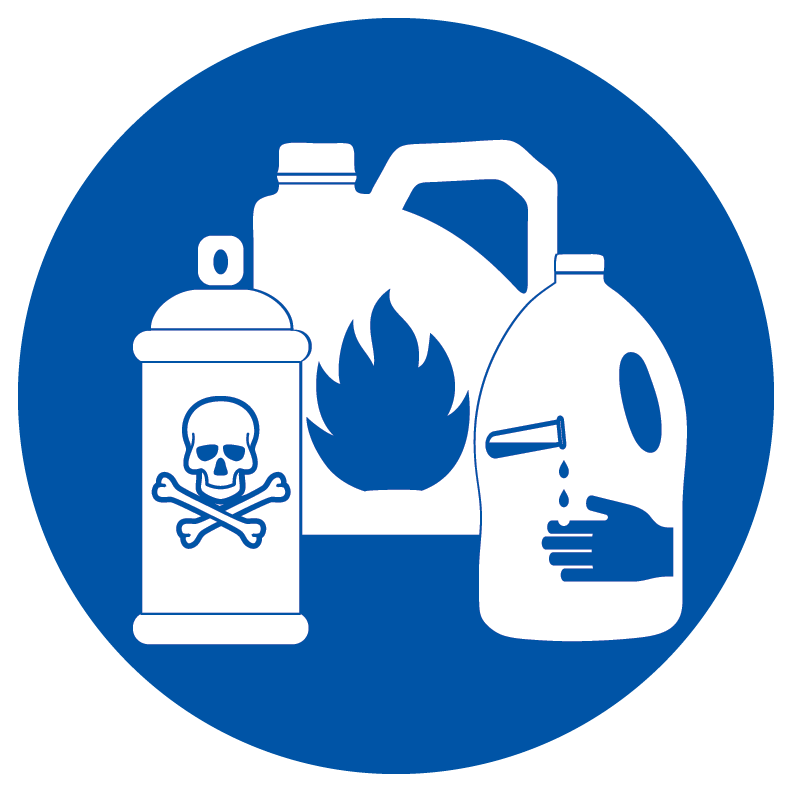Life Saving Rules are essential safety principles that when followed, will protect employees from serious injury or death. These rules were developed around hazards specific to Mauser Packaging Solutions and are focused, clear and simple, actionable, and observable.
HAZARDOUS MATERIALS
What is Chemical Exposure?
Everything is made of chemicals including the food we eat, the water we drink, the clothes we wear and the products we use daily. Chemical Exposure refers to an adverse reaction to skin contact, breathing, or ingestion of a hazardous chemical (see figure to the right). It is not only the type of material that matters, but the amount , or “dose”, that you are expose. In fact, there are already chemicals in our body that we need to live, but which can become harmful at higher levels. The goal is to minimize exposure to safe levels, and to recognize when over-exposure may be happening.

Avoiding Chemical Exposure and Preventing Accidents
- ALWAYS wear your assigned personal protective equipment (PPE)!
- Always check the GHS/HazCom label before handling, dispensing or using any chemical or other hazardous material.
- Read the Safety Data Sheet (SDS) when you are using the chemical or material for the first time. Always follow the guidance and instructions in the SDS.
- If there is no label or if you are unsure of the exact contents of a container – do not touch! Contact your supervisor for instruction on how to handle safely.
- Use an abundance of caution when handling flammable liquids. Only store in and dispense from approved containers – and always away from heat or potential ignition sources.
- Replace PPE when torn, damaged or soiled. Wear face shields when a splash hazard is present.
- Remove all soiled PPE when taking a break and thoroughly wash hands and arms, especially before eating or drinking.
Signs of Hazardous Material Exposure
You may have been exposed to Hazardous material if you:
- You are experiencing dizziness or shortness of breath; start to cough or develop a headache.
- You experience tearing, burning or vision changes if the chemicalgets into your eyes.
- Your skin becomes dried, appears white or red, swelled, blistered or appears as a rash, or burns. There is pain or numbness at the site of contact. If in pain, burning or blistering notify your supervisor immediately.
Remember that a chemical burn may develop later when you are at home. If you develop a blister or pain notify your supervisor and seek medical attention.
Responding to Hazardous Material Exposure
Flush exposed area for a minimum 20 minutes, at sink, eyewash or shower.
Make sure you know the location of the emergency shower and eyewash station and become familiar with how to operate BEFORE you may need it.
DO NOT
- Wait for an exposure to burn/react/itch before flushing.
- Do not use “burn creams,” or antibiotic ointments on chemical burns without the assistance of a medical professional or person trained in first aid. Such treatments may make the exposure worse if not properly selected and/or administered.
Our Commitment to Hazardous Materials:
- I will take actions to prevent exposure to hazardous materials.
- I will never handle or work with materials for which I have not been trained.
- I will always wear the required personal protective equipment when working with chemicals.
- I will report any spills or exposure to hazardous materials immediately.
- I will flush eyes and skin immediately upon accidental contact or splashing for at least 20 minutes, unless otherwise instructed.
- I will identify the location of the nearest eyewash station and shower when working with hazardous materials and maintain clear access to all emergency equipment.

